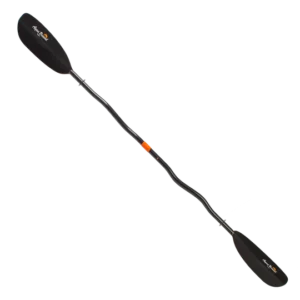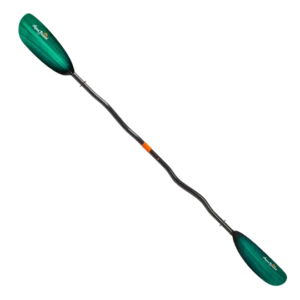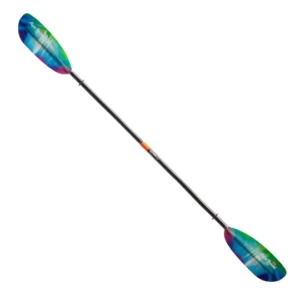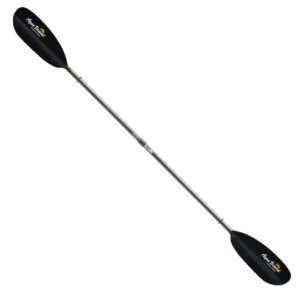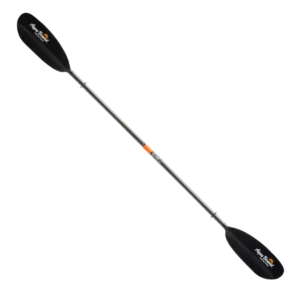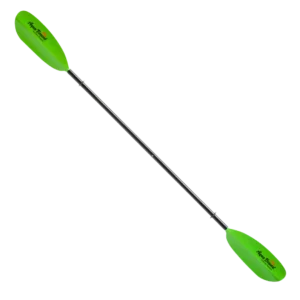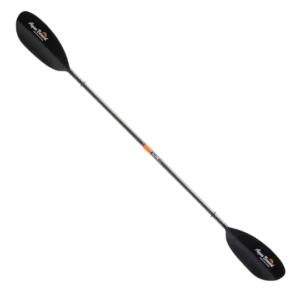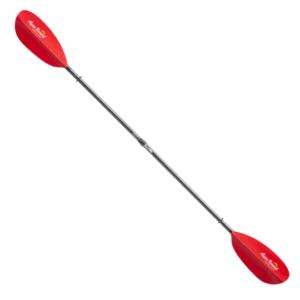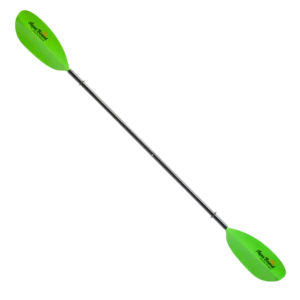
Choosing the Right Paddle
Blade Type
- Blade
Nylon, Fiberglass, Carbon - High Angle
Aggresive, Action, Rough Water - Low Angle
Relaxed, Low Impact, Touring
Blade
When it comes to efficiency, the most efficient stroke is a well trained stroke. The type of paddle can help compliment your forward stroke by improving specific details.
The blade material can play a key role in your stroke efficiency. A nylon blade has a great price point but is very flexible. This means that a substantial amount of your energy is waisted on “flexing” the blade through the water. A fiberglass blade brings together the idea of a more rigid stroke while keeping the price point down. A carbon blade combines the luxury of rigidity and weight.
High Angle
A high angle paddle is typically seen as a shorter fatter blade. It is designed to gain the most surface area with the least amount of blade dive but at a higher angle. This type of paddle stroke is better adapted to fit the aggressive paddler that enjoys a more dynamic environment or fast action maneuvering.
Low Angle
A low angle blade is typically seen as a more oblong shaped blade. These blades are set up to gain substantial surface area with a lower blade dive at a lower angle. It is designed for the paddler that enjoys a leisure paddle with calmer water. It is great for short trips and long distance with efficiency while reducing the impact on your body.
Weight/Efficiency
- Fiberglass
Semi-Lightweight, Durable, Medium Flex - Hybrid
Lighter, Durable, Semi-Hard Flex - Carbon
Lightest, Durable, Hard Flex
Fiberglass
Fiberglass material offers a semi-lightweight option at an affordable price point. The paddle shaft is durable but comes with a bit of flex which can result in waisted energy in your stroke. It is a great choice for shorter day trips in smooth relatively calm water.
Hybrid
A hybrid paddle often refers to the paddle shaft being comprised of a blended mixture of fiberglass and carbon materials. Since carbon is a lighter material it cuts the weight down slightly. Typically dropping the overall weight by a few ounces. Additionally, the shaft is slightly more rigid giving less flex helping to conserve a little more energy with each stroke.
Carbon
A carbon paddle is the “crown jewel” so to speak. The shaft and the blade of the paddle are made of 100% carbon. A carbon paddle will typically promise two very important ingredients: ultra-lightweight, and strong rigidity. The less flex you have in a stroke the more energy you save. It opens the door for better endurance by providing a more distance with less effort.
Length
- Paddler Height
Short, Medium, Tall - Boat Width
Sea, Touring, Recreation - Paddle Style
High, Low, Combination
Paddler Height
Having the correct sized paddle for your body will encourage/enable a more efficient paddling motion. The first thing to consider is your height. The correct paddle size should be approximately one armlength above your head. Of course there are other considerations as well…
Boat Width
When paddling you want to be able to catch the water at a fluid “quiet” angle. When considering a paddle consider the type, style, and the width of the kayak you typically paddle.
A SIT ON TOP recreational kayak will generally seat you higher and have more girth in the catch zone of your paddle stroke. In this case you should consider adding a 5-10cm of length to your paddle based on your height. For example: a 6′ person should have a paddle at around 200cm but if paddling a sit on top recreational kayak a 205-210cm paddle may be more appropriate.
A RECREATIONAL SIT INSIDE kayak will typically seat you lower to the water and be slightly more narrow than a sit on kayak. This alone helps to improve efficiency in the water. A recreational style kayak will still have a few extra inches of width to add stability and comfort to a paddling trip. In this case you may consider adding around 5cm of length to your paddle based on your height.
A SIT IN SEA KAYAK are your touring and rough water champions. These kayaks are long and sleek. They are specifically designed to slice the water for a very efficient and quiet trip. When considering a paddle for a sea kayak you should stay true to your size based on height but could consider even dropping one or two centimeters depending on your paddle angle.
Paddling Style
Last thing to consider is your paddling style referring to high angle or low angle. Traditionally, a LOW ANGLE stroke is affiliated with long distance, recreational, calm smooth waters. It is a more relaxed stroke with a less aggressive approach to the catch and release of you paddle stroke. The blade shape is more oblong spreading out the surface area for a reduced muscle fatigue.
A HIGH ANGLE stroke is more conducive for the aggressive paddler looking for abrupt maneuverability and strong torque with each stroke. The blade shape is often fatter or more egg shaped. It is the ideal tool for dynamic or rough water, surf, or whitewater. It offers more bang per stroke but can also increase muscle fatigue.
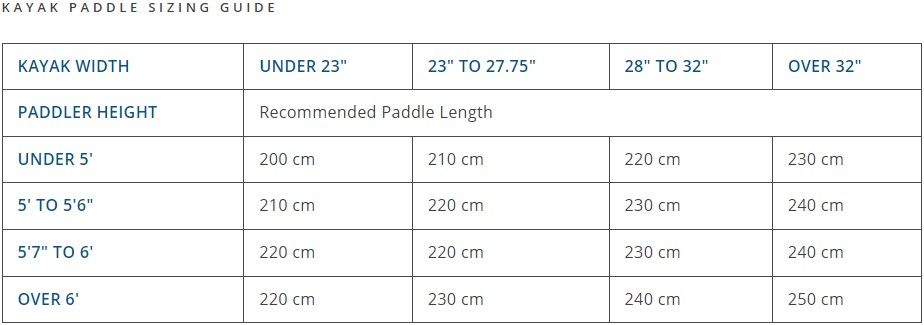
Consultations
If you are unsure about choosing your paddle we are here to help! Please email Justin at [email protected] for a informative discussion on your specific interest.
CALL 843-877-0555 TO ORDER!
Paddle Options
These paddles are being offered pre-order only. Typical wait time is 3-4 weeks, depending on manufacturing.
-
Bent Shaft
Tango Carbon Bent Shaft Posi-Lok™ (Ergonomic)
Rated 0 out of 5$549.95Original price was: $549.95.$469.95Current price is: $469.95. -
Carbon
Tango Carbon Straight Shaft Posi-Lok™
Rated 0 out of 5$424.95Original price was: $424.95.$359.95Current price is: $359.95. -
Bent Shaft
Tango Fiberglass Bent Shaft Posi-Lok™ (Ergonomic)
Rated 0 out of 5$474.95Original price was: $474.95.$419.95Current price is: $419.95. -
Fiberglass
Tango Fiberglass Posi-Lok™
Rated 0 out of 5$349.95Original price was: $349.95.$289.95Current price is: $289.95. -
Carbon
Sting Ray Carbon Versa-Lok™
Rated 0 out of 5$249.95Original price was: $249.95.$219.95Current price is: $219.95. -
Carbon
Sting Ray Carbon Posi-Lok™
Rated 0 out of 5$229.95Original price was: $229.95.$199.95Current price is: $199.95. -
Hybrid
Sting Ray Hybrid Versa-Lok™ (Extendable)
Rated 0 out of 5$199.95Original price was: $199.95.$179.95Current price is: $179.95. -
Hybrid
Sting Ray Hybrid Posi-Lok™
Rated 0 out of 5$179.95Original price was: $179.95.$149.95Current price is: $149.95. -
Fiberglass
Sting Ray Fiberglass Snap Button
Rated 0 out of 5$134.95Original price was: $134.95.$119.95Current price is: $119.95. -
Carbon
Manta Ray Carbon Versa-Lok™ (Extendable)
Rated 0 out of 5$249.95Original price was: $249.95.$219.95Current price is: $219.95. -
Carbon
Manta Ray Carbon Posi-Lok™
Rated 0 out of 5$229.95Original price was: $229.95.$189.95Current price is: $189.95. -
High Angle
Manta Ray Hybrid Versa-Lok™ (Extendable)
Rated 0 out of 5$199.95Original price was: $199.95.$179.95Current price is: $179.95. -
High Angle
Manta Ray Hybrid Posi-Lok™
Rated 0 out of 5$179.95Original price was: $179.95.$149.95Current price is: $149.95. -
Fiberglass
Manta Ray Fiberglass Snap Button
Rated 0 out of 5$134.95Original price was: $134.95.$119.95Current price is: $119.95.

CALL 843-877-0555 TO ORDER!
A 30% deposit is required at the time of order. After January 1st, any cancelled orders will forfeit the deposit amount.

